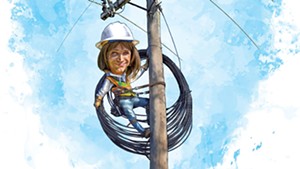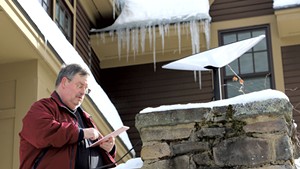
- Greg Nesbit
- Bryce Boyer
When Liv Boyer had to attend a Zoom lecture during the pandemic, she'd shout a warning to her two homeschooled siblings, her mother and her father to power down their devices: "Hey! Everyone off!" the high schooler would yell across the family's North Bennington home.
Multiple users would cause the streaming audio to stutter and the video to freeze; she'd have no choice but to miss class.
The slow connection was difficult for the rest of the family, as well. Liv's father, Bryce, a commercial photographer, often has to send large files to clients. Bryce was used to making a 50-minute round-trip trek to the town's library — which has high-speed internet — to submit photography files. Sometimes, he made the trip three or four times per day if his client requested last-minute edits. It was exhausting.
The Boyers had tried all sorts of options in an attempt to boost their internet speed. They even invested $500 to install a Starlink satellite dish, which ended up running slower than the cable hookup they had relied on.
The family had expected slow Wi-Fi when they relocated to Vermont from Colorado five years ago. But the poor connection, Bryce acknowledged, was more detrimental to his family than anticipated.
All that changed a few weeks ago when the Southern Vermont Communications Union District hooked the Boyers up to high-speed fiber-optic cable as part of the state's ambitious broadband deployment strategy, which is in its first stages of implementation.
"We saw the trucks as they started to lay the cable, and I couldn't believe it," Boyer said. Technicians connected the family to a fiber-optic line for free. For $70 a month, the Boyers receive 800 megabits per second of speed — an upgrade, Bryce said, that has changed their lives. Now, Bryce can upload his photos from home, and the whole family can be online at once.
"It's amazing so far," he said. "I can actually get work done."
The Boyers are among the rural Vermonters who are being connected to fiber for the first time, thanks to an influx of COVID-19 relief money directed at getting the state up to speed. The undertaking is nearly a decade in the making and has had a number of false starts. But the creation of the Vermont Community Broadband Board in 2021, established by Act 71 of the state legislature, is finally paying off — at least for some.
Slowly, the state's communication union districts — which cover 213 of Vermont's 251 towns — are connecting residents to fiber, street by street, home by home. This month, residents in five Chittenden County municipalities voted to form the state's 10th CUD. Even in Vermont's most populous county, some residents lack reliable internet.
Five of the 10 CUDs have started the build-out, and just under 1,000 customers have been connected in recent months. Most CUDs are only starting to work through their list of neighborhoods, though one, ECFiber, the state's groundbreaking CUD, has existed for years and had thousands of customers already.
Access to high-speed broadband has marked a significant quality-of-life upgrade for families such as the Boyers. They can work remotely with ease; schoolchildren can participate in extracurricular activities, and telemedicine is finally an option.
"What this rollout means is that Vermont is going to be a leader in the country in terms of being able to provide world-class broadband virtually anywhere in the state," said F.X. Flinn, chair of ECFiber. "That is going to have profound implications for the next generation or two."
There has been little financial incentive for private providers to build out fiber networks in rural areas; it's costly to lay lines across sprawling landscapes with few customers. But by establishing CUDs, the broadband board has been able to help pay to establish networks. "You can now say: 'What's the best way to do this?' Not 'What's the most profitable way to do this?'" Flinn explained.
Most important, though, has been the federal money being funneled into the project. In July, Gov. Phil Scott announced $47.8 million in grants to support high-speed internet connectivity projects across the state. That means the state has more than $245 million in total broadband investments, mostly generated from American Rescue Plan Act funds. But Christine Hallquist, executive director of the broadband board, a state-run group that develops policies and programs to accelerate broadband connection, estimates that it will take $550 million to connect every Vermont household. She's hoping that the CUDs make up the difference with revenue bonds and creative financing models.
Legislators have tried to make sure that the upgrade does not place an undue burden on taxpayers. A CUD can fund its operations by using bonds backed by the revenue from projects, grants or gifts.
Currently, around 60,000 households across Vermont do not have access to reliable high-speed internet. Hallquist predicts that the number of homes getting connected by fiber will soar in 2023 and that the entire state will be connected in five years.
"I think there's a lot of excitement, a lot of anticipation and also a lot of impatience," said Robert Fish, deputy director of the broadband board. "Everyone wanted this yesterday."

- Greg Nesbit
- Liv Boyer
Building out the fiber network is a challenge. Supply chain issues and labor shortages have proven to be the biggest hiccups so far. Luckily, the broadband board purchased more than 2,000 miles of fiber a year ago, anticipating such problems.
But Flinn, chair of ECFiber, said he's been having trouble staffing his installation routes. "Now that the money situation is in hand, labor is turning out to be a big barrier," he said.
Hallquist, who has set up a robust Vermont-based training program for electrical technicians, told Seven Days that the broadband board is targeting, recruiting and training people to work on all aspects of the build-out. Through apprenticeship programs, tuition assistance for job training, job placement and an earn-to-learn program, Hallquist is hoping to fill the hiring gap. If worse comes to worst, though, the board is ready to hire technicians from Canada.
Despite staffing shortages, Vermonters are getting wired. Ed Sinnamon, a 68-year-old retiree in Bolton, said that just days after technicians associated with Waitsfield and Champlain Valley Telecom came to his neighborhood, they arrived at his house. "And bang!" he recalled, "all of a sudden we had broadband."
Sinnamon and his wife had not been too concerned about their Wi-Fi speed until COVID-19 hit. Suddenly, their less-than-reliable service was their link to the world. The couple tried to FaceTime with their daughter, who lives in Connecticut, but the connection was too weak. Their church's live-streamed sermons were difficult to watch. And as members of Bolton's Economic Resource Committee, the couple struggled to participate in meetings. People would assume they weren't even attending.
"We would say, 'We're right here! We're talking to you!' But no one could hear us," he lamented.
Now? "Everyone's saying, 'You've never looked so good!' 'You're crystal clear!' 'We can hear you!'" Sinnamon gushed. The quality of his wife's telemedicine appointments has improved, he said.
For rural Vermonters, broadband access is an issue of equity. Without easy access to telemedicine, remote job opportunities and schooling, Vermont's rural population could fall behind on multiple fronts. "We're seeing an economic divide that results from this digital divide," Hallquist explained.
These realities also make it difficult to attract new residents to the state and grow Vermont's economy. Real estate with reliable Wi-Fi generally fetches a higher price. Without high-speed service, it's difficult for towns to draw newcomers or retain their young residents.
Many rural Vermonters, though, are trying to be patient as they wait for a high-speed connection. Andrea Burke, who lives in Halifax with her husband and four children, was told that her house would be hooked up in the next 12 to 24 months. "It just seems like forever away," she groaned. "It's so painful."
Burke, who works remotely for a Connecticut-based company, often spends the day parked in front of her kids' school, where there is a hot spot, working from her car. When her kids attended school remotely during the pandemic, one of her sons had to choose between having his camera on during class — which his teacher required — or being able to actually hear the lesson. He worries that his first-year GPA, which was negatively affected by his less-than-reliable Wi-Fi speed, will hinder his chances of getting into his dream college, Burke said.
The broadband rollout has been compared to Vermont's rural electrification project decades ago. It wasn't until 1964 that the Northeast Kingdom town of Granby was finally connected to the power grid.
"The internet is the electricity of our era," Burke said, citing the huge disparities in rural broadband connection. But she's looking forward to the day when her family is finally connected. "I'm really excited by how different my life is going to be, how much more efficient it's going to be."
Correction, November 28, 2022: ECFiber has thousands of customers. An earlier version of this story contained an error.














Comments
Comments are closed.
From 2014-2020, Seven Days allowed readers to comment on all stories posted on our website. While we've appreciated the suggestions and insights, right now Seven Days is prioritizing our core mission — producing high-quality, responsible local journalism — over moderating online debates between readers.
To criticize, correct or praise our reporting, please send us a letter to the editor or send us a tip. We’ll check it out and report the results.
Online comments may return when we have better tech tools for managing them. Thanks for reading.